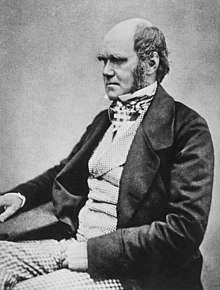Charles Darwin | |
|---|---|
 | |
| Born | Charles Robert Darwin 12 February 1809 Shrewsbury, Shropshire, England |
| Died | 19 April 1882 (aged 73) |
| Resting place | Westminster Abbey |
| Alma mater | |
| Known for | Natural selection |
| Spouse | |
| Children | 10, including William, Henrietta, George, Francis, Leonard and Horace |
| Parents | |
| Family | Darwin–Wedgwood |
| Awards |
|
| Writing career | |
| Notable works | |
| Scientific career | |
| Fields | |
| Institutions | Geological Society of London |
| Academic advisors | |
| Author abbrev. (botany) | Darwin |
| Author abbrev. (zoology) | Darwin |
| Signature | |
 | |
Charles Robert Darwin FRS FRGS FLS FZS JP[5] (/ˈdɑːrwɪn/[6] DAR-win; 12 February 1809 – 19 April 1882) was an English naturalist, geologist, and biologist,[7] widely known for his contributions to evolutionary biology. His proposition that all species of life have descended from a common ancestor is now generally accepted and considered a fundamental scientific concept.[8] In a joint publication with Alfred Russel Wallace, he introduced his scientific theory that this branching pattern of evolution resulted from a process he called natural selection, in which the struggle for existence has a similar effect to the artificial selection involved in selective breeding.[9] Darwin has been described as one of the most influential figures in human history and was honoured by burial in Westminster Abbey.[10][11]
Darwin's early interest in nature led him to neglect his medical education at the University of Edinburgh; instead, he helped to investigate marine invertebrates. His studies at the University of Cambridge's Christ's College from 1828 to 1831 encouraged his passion for natural science.[12] However, it was his five-year voyage on HMS Beagle from 1831 to 1836 that truly established Darwin as an eminent geologist. The observations and theories he developed during his voyage supported Charles Lyell's concept of gradual geological change. Publication of his journal of the voyage made Darwin famous as a popular author.[13]
Puzzled by the geographical distribution of wildlife and fossils he collected on the voyage, Darwin began detailed investigations and, in 1838, devised his theory of natural selection.[14] Although he discussed his ideas with several naturalists, he needed time for extensive research, and his geological work had priority.[15] He was writing up his theory in 1858 when Alfred Russel Wallace sent him an essay that described the same idea, prompting the immediate joint submission of both their theories to the Linnean Society of London.[16] Darwin's work established evolutionary descent with modification as the dominant scientific explanation of natural diversification.[17] In 1871, he examined human evolution and sexual selection in The Descent of Man, and Selection in Relation to Sex, followed by The Expression of the Emotions in Man and Animals (1872). His research on plants was published in a series of books, and in his final book, The Formation of Vegetable Mould, through the Actions of Worms (1881), he examined earthworms and their effect on soil.
Darwin published his theory of evolution with compelling evidence in his 1859 book On the Origin of Species.[18][19] By the 1870s, the scientific community and a majority of the educated public had accepted evolution as a fact. However, many initially favoured competing explanations that gave only a minor role to natural selection, and it was not until the emergence of the modern evolutionary synthesis from the 1930s to the 1950s that a broad consensus developed in which natural selection was the basic mechanism of evolution.[17][20] Darwin's scientific discovery is the unifying theory of the life sciences, explaining the diversity of life.
- ^ Freeman 2007, p. 76.
- ^ "Charles Darwin's personal finances revealed in new find". The Telegraph. 22 March 2009. Archived from the original on 19 October 2017.
- ^ "Search Results: Record – Darwin; Charles Robert". The Royal Society Collections Catalogues. 20 June 2015. Archived from the original on 2 December 2021. Retrieved 2 December 2021.
- ^ a b c d e Freeman 2007, p. 106.
- ^ van Wyhe, John; Chua, Christine. Charles Darwin: Justice of the Peace: The Complete Records (1857–1882) (PDF). Archived (PDF) from the original on 3 August 2022. Retrieved 3 August 2022.
- ^ "Darwin" Archived 18 July 2014 at the Wayback Machine entry in Collins English Dictionary.
- ^ Desmond, Moore & Browne 2004.
- ^ Coyne, Jerry A. (2009). Why Evolution is True. Viking. pp. 8–11. ISBN 978-0-670-02053-9.
- ^ Larson 2004, pp. 79–111.
- ^ "Special feature: Darwin 200". New Scientist. Archived from the original on 11 February 2011. Retrieved 2 April 2011.
- ^ Cite error: The named reference
Westminster Abbey-2016was invoked but never defined (see the help page). - ^ Leff 2000, About Charles Darwin.
- ^ Desmond & Moore 1991, pp. 210, 284–285.
- ^ Desmond & Moore 1991, pp. 263–274.
- ^ van Wyhe 2007, pp. 184, 187
- ^ Beddall, B. G. (1968). "Wallace, Darwin, and the Theory of Natural Selection". Journal of the History of Biology. 1 (2): 261–323. doi:10.1007/BF00351923. ISSN 0022-5010. S2CID 81107747.
- ^ a b van Wyhe 2008.
- ^ Coyne, Jerry A. (2009). Why Evolution is True. Oxford: Oxford University Press. p. 17. ISBN 978-0-19-923084-6.
In The Origin, Darwin provided an alternative hypothesis for the development, diversification, and design of life. Much of that book presents evidence that not only supports evolution but at the same time refutes creationism. In Darwin's day, the evidence for his theories was compelling but not completely decisive.
- ^ Glass, Bentley (1959). Forerunners of Darwin. Baltimore, MD: Johns Hopkins University Press. p. iv. ISBN 978-0-8018-0222-5.
Darwin's solution is a magnificent synthesis of evidence ... a synthesis ... compelling in honesty and comprehensiveness
. - ^ Bowler 2003, pp. 178–179, 338, 347.